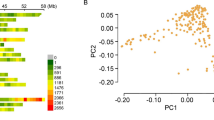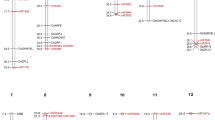Abstract
Supernodulation in soybean (Glycine max L. Merr.) is an important source of nitrogen supply to subterranean ecological systems. Single nucleotide-amplified polymorphism (SNAP) markers for supernodulation should allow rapid screening of the trait in early growth stages, without the need for inoculation and phenotyping. The gene GmNARK (Glycine max nodule autoregulation receptor kinase), controlling autoregulation of nodulation, was found to have a single nucleotide polymorphism (SNP) between the wild-type cultivar Sinpaldalkong 2 and its supernodulating mutant, SS2-2. Transversion of A to T at the 959-bp position of the GmNARK sequence results in a change of lysine (AAG) to a stop codon (TAG), thus terminating its translation in SS2-2. Based on the identified SNP in GmNARK, five primer pairs specific to each allele were designed using the WebSnaper program to develop a SNAP marker for supernodulation. One A-specific primer pair produced a band present in only Sinpaldalkong 2, while two T-specific pairs showed a band in only SS2-2. Both complementary PCRs, using each allele-specific primer pair were performed to genotype supernodulation against F2 progeny of Sinpaldalkong 2 × SS2-2. Among 28 individuals with the normal phenotype, eight individuals having only the A-allele-specific band were homozygous and normal, while 20 individuals were found to be heterozygous at the SNP having both A and T bands. Twelve supernodulating individuals showed only the band specific to the T allele. This SNAP marker for supernodulation could easily be analyzed through simple PCR and agarose gel electrophoresis. Therefore, use of this SNAP marker might be faster, cheaper, and more reproducible than using other genotyping methods, such as a cleaved amplified polymorphic sequence marker, which demand of restriction enzymes.






Similar content being viewed by others
References
Akao S, Kouchi H (1992) A supernodulating mutant isolated from soybean cultivar Enrei. Soil Sci Plant Nutr 38:183–187
Andersen JR, Lubberstedt T (2003) Functional markers in plants. Trends Plant Sci 8:554–560
Ashburner M (1990) Drosophila: a laboratory handbook. Cold Spring Harbor Laboratory Press, Cold Spring Harbor
Cai H, White PS, Torney D, Deshpande A, Wang Z, Marrone B, Nolan JP (2000) Flow cytometry-based minisequencing: a new platform for high throughput single-nucleotide polymorphism scoring. Genomics 66:135–143
Carroll BJ, McNeil DL, Gresshoff PM (1985a) Isolation and properties of soybean [Glycine max (L) Merr.] mutants that nodulate in the presence of high nitrate concentrations. Proc Natl Acad Sci USA 94:773–781
Carroll BJ, McNeil DL, Gresshoff PM (1985b) A supernodulation and nitrate-tolerant symbiotic (nts) soybean mutant. Plant Physiol 78:34–40
Chen J, Iannone MA, Li M-S, Taylor JD, Rivers P, Nelson AJ, Slentz-Kesler KA, Roses A, Weiner MP (2000) A microsphere-based assay for multiplexed single nucleotide polymorphism analysis using single base chain extension. Genome Res 10:549–557
Drenkard E, Richter BG, Rozen S, Stutius LM, Angell NA, Mindrinos M, Cho RJ, Oegner PJ, Davis RW, Ausubel FM (2000) A simple procedure for the analysis of single nucleotide polymorphisms facilitates map-based cloning in Arabidopsis. Plant Physiol 124:1483–1492
Greene E, Codomo CA, Taylor NE, Henikoff JG, Till BJ, Reynolds SH, Enns LC, Burtner C, Johnson JE, Odden AR, Comai L, Henikoff S (2003) Spectrum of chemically induced mutations from a large-scale reverse-genetic screen in Arabidopsis. Genetics 164:731–340
Gupta PK, Roy JK, Prasad M (2001) Single nucleotide polymorphisms: a new paradigm for molecular marker technology and DNA polymorphism detection with emphasis on their use in plants. Curr Sci 80:524–535
Gut IG (2001) Automation in genotyping of single nucleotide polymorphisms. Hum Mutat 17:475–492
Ha B-K, Lee S-H (2001) Genetic mapping of hypernodulation in soybean mutant SS2-2. Korean J Crop Sci 46:416–419
Hayashi K, Hashimoto N, Daigen M, Ashikawa I (2004) Development of PCR-based SNP markers for rice blast resistance genes at the Piz locus. Theor Appl Genet 108:1212–1220
Horsfall MJ, Gordon AJE, Burns PA, Zielenska M, van der Vliet ME, Glickman BW (1990) Mutational specificity of alkylating agents and the influence of DNA repair. Environ Mol Mutagen 15:107–122
Innis MA, Myambo KB, Gelfand DH, Brow MAD (1988) DNA sequencing with Thermus aquaticus DNA polymerase and direct sequencing of polymerase chain reaction-amplified DNA. Proc Natl Acad Sci USA 85:9436–9440
Kim MY, Ha B-K, Jun T-H, Hwang E-Y, Van K, Kuk YI, Lee S-K (2004) Single nucleotide polymorphism discovery and linkage mapping of lipoxygenase-2 gene (Lx2) in soybean. Euphytica 135:169–177
Kolchinsky A, Landau-Ellis D, Gresshoff PM (1997) Map order and linkage distances of molecular markers close to the supernodulation (nts-1) locus of soybean. Mol Gen Genet 254:29–36
Konieczny A, Ausubel F (1993) A procedure for mapping Arabidopsis mutations using co-dominant ecotype-specific PCR-based markers. Plant J 4:403–410
Landau-Ellis D, Angermuller S, Shoemaker R (1991) The genetic locus controlling supernodulation in soybean (Glycine max L.) co-segregates tightly with a cloned molecular marker. Mol Gen Genet 228:221–226
Lee HS, Chae YA, Park EH, Kim YW, Yun KI, Lee S-H (1997) Introduction, development, and characterization of supernodulating soybean mutant. I. Mutagenesis of soybean and selection of supernodulating mutant. Korean J Crop Sci 42:247–253
Lee HS, Kim YW, Park EH (1998) Introduction, development, and characterization of supernodulating soybean mutant: Shoot factor regulation of nodule development in supernodulating soybean mutant. Korean J Crop Sci 43:28–31
Livak KJ (1999) Allelic discrimination using fluorogenic probe and the 5′ nuclease assay. Genet Anal 14:143–149
Men AE, Laniya TS, Iturbe-Dramaetxe I, Gresshoff I, Jiang Q, Carroll BJ, Gresshoff PM (2002) Fast neutron mutagenesis of soybean (Glycine soja L.) produces a supernodulating mutant containing a large deletion in linkage group H. Genome Lett 3:147–155
Michaels SD, Amasino RM (1998) A robust method for detecting single-nucleotide changes as polymorphic markers by PCR. Plant J 14:381–385
Neff MM, Neff JD, Chory J, Pepper AE (1998) dCAPS, a simple technique for the genetic analysis of single nucleotide polymorphisms: experimental applications in Arabidopsis thaliana genetics. Plant J 14:387–392
Pastink A, Heemskerk E, Nivard MJ, van Vliet CJ, Vogel EW (1991) Mutational specificity of ethyl methanesulfonate in excision–repair-proficient and -deficient strains of Drosophila melanogaster. Mol Gen Genet 229:213–218
Pierce M, Bauer WD (1983) A rapid regulatory response governing nodulation in soybean. Plant Physiol 73:286–290
Sachidanandam R, Weissman D, Schmidt SC, Kakol JM, Stein LD, Marth G, Sherry S, Mullikin JC, Mortimore BJ, Willey DL, Hunt SE, Cole CG, Coggill PC, Rice CM, Ning Z, Rogers J, Bentley DR, Kwok PY, Mardis ER, Yeh RT, Schultz B, Cook L, Davenport R, Dante M, Fulton L, Hillier L, Waterston RH, McPherson JD, Gilman B, Schaffner S, Van Etten WJ, Reich D, Higgins J, Daly MJ, Blumenstiel B, Baldwin J, Stange-Thomann N, Zody MC, Linton L, Lander ES, Altshuler D (2001) A map of human genome sequence variation containing 1.42 million single nucleotide polymorphisms. Nature 409:928–933
Searle IR, Men AE, Laniya TS, Buzas DM, Iturbe-Ormaetxe I, Carroll BJ, Gresshoff PE (2003) Long-distance signaling in nodulation directed by a CLAVATA1-like receptor kinase. Science 299:109–112
Shi MM (2001) Enabling large-scale pharmacogenetic studies by high-throughput mutation detection and genotyping technologies. Clin Chem 47:164–172
Shure M, Wessler S, Fedoreff N (1983) Molecular identification and isolation of the waxy locus in maize. Cell 35:225–233
Stonesifer J, Baltz RH (1985) Mutagenic DNA repair in Streptomyces. Proc Natl Acad Sci USA 82:1180–1183
Syvänen A-C (2001) Accessing genetic variation: genotyping single nucleotide polymorphisms. Nature Rev Genet 2:930–942
Taylor JD, Briley D, Nguyen Q, Long K, Iannone MA, Li M-S, Ye F, Afshari A, Lai E, Wagner M, Chen J, Weiner MP (2001) Flow cytometric platform for high-throughput single nucleotide polymorphism analysis. Biotechniques 30:661–669
Todd PA, Brouwer J, Glickman BW (1981) Influence of DNA repair deficiencies on MMS- and EMS-induced mutagenesis in Escherichia coli K12. Mutat Res 82:239–250
Vidal A, Abril N, Pueyo C (1995) DNA repair by Ogt alkyl-transferase influences EMS mutational specificity. Carcinogenesis 16:817–821
Ye F, Li M-S, Taylor JD, Nguyen Q, Colton HM, Casey WM, Wagner M, Weiner MP, Chen J (2001) Fluorescent microsphere-based readout technology for multiple human single nucleotide polymorphism analysis and bacterial identification. Hum Mutat 17:305–316
Zhu YL, Song QJ, Hyten SM, Fickus EW, Young ND, Cregan PB (2003) Single-nucleotide polymorphism in soybean. Genetics 163:1123–1134
Acknowledgements
This research was also supported by a grant (code no. CG3121) from Crop Functional Genomic Center of the 21st Century Frontier Research Program funded by the Ministry of Science and Technology (MOST) and Rural Development Administration (RDA) of the Republic of Korea. We also thank the National Instrumentation Center for Environmental Management at Seoul National University in Korea, and the International Atomic Energy Agency in Austria.
Author information
Authors and Affiliations
Corresponding author
Additional information
Communicated by S.J. Knapp
Rights and permissions
About this article
Cite this article
Kim, M.Y., Van, K., Lestari, P. et al. SNP identification and SNAP marker development for a GmNARK gene controlling supernodulation in soybean. Theor Appl Genet 110, 1003–1010 (2005). https://doi.org/10.1007/s00122-004-1887-2
Received:
Accepted:
Published:
Issue Date:
DOI: https://doi.org/10.1007/s00122-004-1887-2




